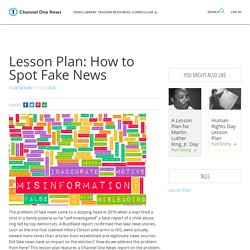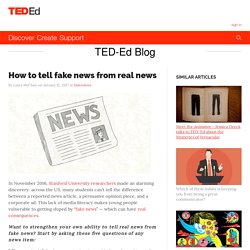

SWR-Fakefinder - Online Game. Identifying Fake News: An Infographic and Educator Resources - EasyBib Blog. Lesson Plan: How to Spot Fake News. The problem of fake news came to a dizzying head in 2016 when a man fired a shot in a family pizzeria as he “self-investigated” a false report of a child abuse ring led by top democrats.

A BuzzFeed report confirmed that fake news stories, such as the one that claimed Hillary Clinton sold arms to ISIS, were actually viewed more times than articles from established and legitimate news sources. Did fake news have an impact on the election? How do we address the problem from here? This lesson plan features a Channel One News report on the problem.
Then, students analyze the problem and consider steps media outlets and individuals need to take to prevent the viral spread of propaganda. Opening Activity Warm up: Ask students: How do you get your news? Words in the News: Review this word prior to viewing the video. propaganda (noun): Information that is often exaggerated or false and spread for the purpose of benefiting or promoting a specific individual or cause. Discuss. 10 Ways to Spot a Fake News Article - EasyBib Blog. For many of us, 2016 is going down as a year to forget.

Election upsets, Zika, the Syrian crisis, and unfortunately tons of fake news about all of the above and everything in between. Denzel Washington was recently quoted as saying, “If you don’t read the newspaper, you’re uninformed. If you do read the newspaper, you’re misinformed.” So what should you do? You want to be informed, but a good deal of the information out there is incorrect or biased. 1. Links and citations allow us to easily access, read, and explore more about the information found in the article.
Many big name news sites, such as CNN, do not include links or citations, but other sites do. 2. An article without an author’s name is another red flag. 3. Do a Google search on the author’s name to find their occupation and locate other articles that the author has composed. 4. On the top or bottom of most websites, you should see a section titled “About Us.” How to outsmart fake news in your Facebook feed. It doesn't have to be this way. Fake news is actually really easy to spot -- if you know how. Consider this your New Media Literacy Guide. 1. Does the story come from a strange URL? Zimdars says sites with strange suffixes like ".co" or ".su," or that are hosted by third party platforms like WordPress should raise a red flag. 2.
Mantzarlis says one of the biggest reasons bogus news spreads on Facebook is because people get sucked in by a headline and don't bother to click through. Just this week, several dubious organizations circulated a story about Pepsi CEO Indra Nooyi. However, the articles themselves didn't contain that quote nor evidence that Pepsi's stock saw a significant drop (it didn't). 3. Sometimes legitimate news stories can be twisted and resurrected years after the fact to create a false conflation of events. A blog called Viral Liberty recently reported that Ford had moved production of some of their trucks from Mexico to Ohio because of Donald Trump's election win. 4. 5. Teaching critical thinking to combat fake news and bullshit: You have to start young. As much as I like to deconstruct pseudoscientific claims, particularly about health, medicine, and health care, Sometimes it gets a bit draining.

There’s just so much pseudoscience, so much credulity, so much sheer idiocy out there that trying to refute them and encourage a more skeptical mindset often feels like pissing into the ocean, for all the effect it has. In the age of fake news and Donald Trump, it even feels as though we’re going backward—and not slowly, either.
That’s why I felt it was time for a bit of a break, a bit more optimism than I’ve been able to muster before. So it was a good thing that I happened across an article by Julia Belluz and Alvin Chang entitled This researcher may have discovered the antidote to health bullshit. Yes, as Andy Oxman shows, you have to get ’em young. “I told them that some teenagers had discovered that red M&Ms gave them a good feeling in their body and helped them write and draw more quickly,” Oxman said. Noting: Related December 30, 2016. How to tell fake news from real news.
In November 2016, Stanford University researchers made an alarming discovery: across the US, many students can’t tell the difference between a reported news article, a persuasive opinion piece, and a corporate ad.

This lack of media literacy makes young people vulnerable to getting duped by “fake news” — which can have real consequences.